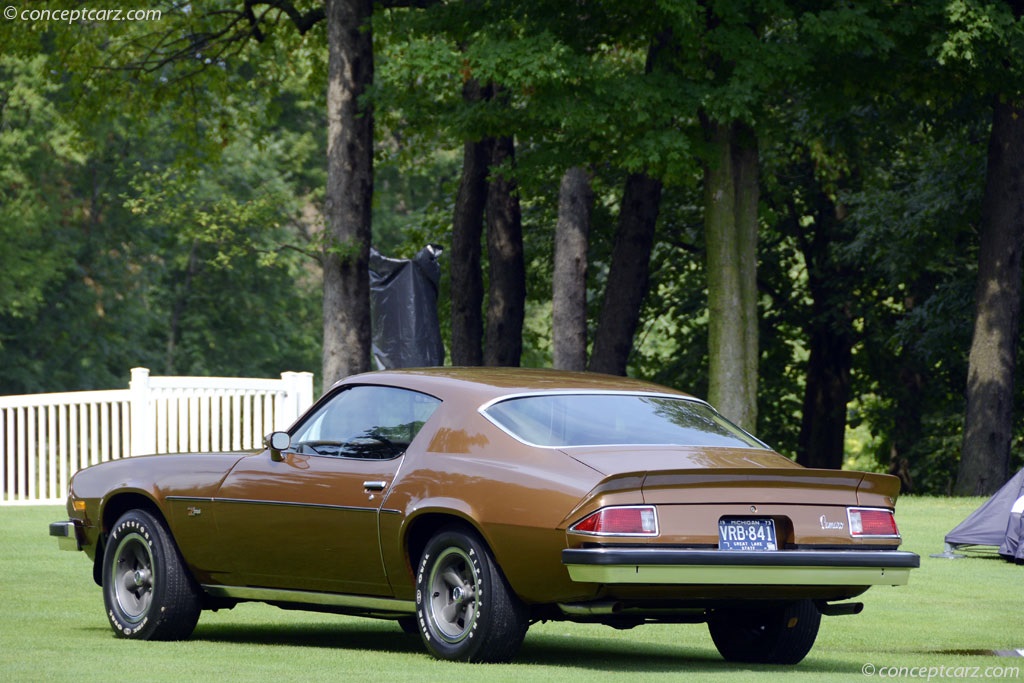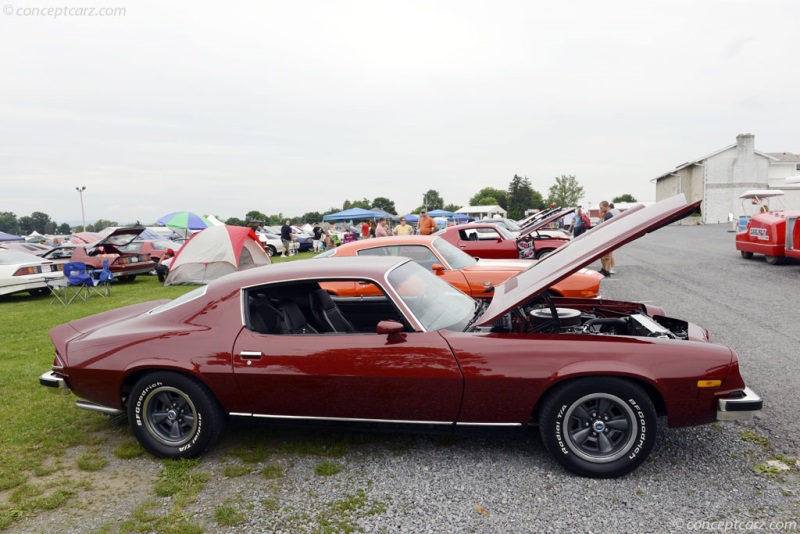1974 Chevrolet Camaro Navigation
The second-generation Chevy Camaro lasted from 1970 through 1981. Introduced in the spring of 1970, it was offered solely as a coupe making it the only generation of the Camaro without a convertible option. Although a new design, much of the drivetrain and engines were carried over from 1969, although the previous 230 cubic-inch six was dropped and the new 'base' engine was the 250 CID six with 155 horsepower. The Camaro SS 396 came standard with the 396 cubic-inch L78 V8 with 350 horsepower. The displacement actually measured 402 cubic inches, but Chevrolet wanted to retain the 396 badges, so continued to list the big-block as 396 CID. With a single four-barrel Holley carburetor, the engine produced 375 horsepower and 415 lb-ft of torque. Early sales brochures and specifications listed two 454 cubic-inch V8s (the LS6 and LS7), but they never made it into the production 1970 Camaro. 
LT Hardtop CoupeThe suspension incorporated a new rear stabilizer bar (the first for the Camaro) and the previous four-wheel disc option was no longer offered.The vast list of trim options made the 1970 Camaro very versatile, catering to economy, luxury, and performance. Options included the 'base,' Rally Sport, Super Sport, and the Z-28 Special Performance Package with a new high-performance LT-1 with 360 horsepower. The new body designs were devoid of rear side quarter windows, with wider doors, ventless full-door glass, and a fastback roofline. Per rollover requirements and improved safety, the Camaro's roof used a new double-shell unit that offered protection and noise reduction. The base model had parking lights under the separate bumper and grille design, while the Rally Sport wore a unique grille surrounded by a flexible Endura material. On both sides of the grille, the round parking lights were located beside the headlights and bumperettes. Four round taillights were in the back with a similar design to its Corvette sibling. 
LT Hardtop Coupe
View info and historyThe curved instrument panel was new, housing several switches and round dials for gauges in the upper section, while the lower portion had the heating and air conditioning controls. The glovebox door was on the far right, and the radio, cigarette lighter and ashtray were in the center. The 1970 model year was the only year for the Strato bucket seats with squared-off seatbacks and adjustable headrests. in the back were a pair of two bucket cushions and a bench seatback. The interior was done in all-vinyl upholstery while the dashboard had a matte black finish. Cloth or vinyl upholstery was optional, along with woodgrain trim on the dash and console. For 1971, the Camaro received high-back Strato bucket seats with built-in headrests. General Motors mandated that all its engines would need to operate on lower-octane regular-leaded, low-lead, or unleaded gasoline. Thus, compression ratios and horsepower ratings were reduced. 
Hardtop CoupeA 67-day corporate-wide strike at GM, coupled with a decline in the pony car market due to the increasing insurance rates, brought about rumors of the possible cancellation of the Camaro. Another worker's strike at the assembly plant at Norwood, Ohio - which built Camaros and Firebirds - nearly confirmed those rumors. The disruption at Norwood halted production for 174 days, and approximately 1,100 incomplete Camaros had to be scrapped as they did not comply with the new 1973 federal bumper safety standards. Despite the setback, Chevrolet produced 68,656 Camaros in 1972, convincing management to reconsider its extinction. 1972 was the final year for the SS 396 and SS 350 models, along with the Big Block Camaro from the factory. Additionally, the 'Z/28' badge changed to 'Z28.'New impact-absorbing front bumpers were added in 1973 to comply with new no-damage standards in 5 miles per hour NHTSA legislation. A new Type LT model was introduced, adding a more luxurious, quieter, and better-appointed interior with full instrumentation, variable-ratio steering, hidden windshield wipers, sport mirrors, and Rally-style wheels. The Z28 was available on the sports coupe and LT models. Camaro sales were strong for 1973, with 96,751 units finding new homes. The 1974 Camaro
For 1974, the Camaro was given a major restyling, and the LT package (first appearing in 1973) continued to be part of the options list. The LT package was a 'luxury' package while the Z/28 option was a 'performance' and 'appearance' package. The Z28 option added bolder graphics and decals, stripes that ran the length of the hood and deck lid, and a 350 cubic-inch V8 rated at 245 horsepower. This was the final year for the RPO Z28 before it briefly entered retirement, only to be revived in 1977 as its own model instead of an RPO. The overall length of the 1974 Camaro grew by seven inches due to the new aluminum bumpers and a forward-sloping grille. In the back, the previous round taillights were replaced with a rectangular wraparound design. It had an egg-crate-type grille, and this was the final year for the flat rear window, with thick roof pillars. Later years wore slimmer roof pillars and a wraparound rear window.For 1974, the Camaro was given a forward-angled grille, wider front bumpers, and an egg-crate-type grill. The four-round taillamps were replaced with large lenses that wrapped around the body corners. Pricing for the base coupe began at $3,160 while the LT option sold for $3,715. For 1974, Chevrolet produced 146,595 Camaro's for the domestic market, with 4,142 being built for export. 13,803 examples were fitted with the Z28 package, the highest figure for the 2nd-generation Z28 Camaro. The dramatic increase in sales is partly attributed to Ford downsizing its Mustang to the all-new Mustang II subcompact based on the Pinto. While this may have helped Camaro sales, the Mustang II sales were also positive with 385,993 units produced for the model year, spurred on the energy crises, high gas prices, fuel shortages, and the Arab Oil Embargo. Additionally, Mercury moved its Cougar to a larger, intermediate-sized platform where it could better compete in the personal luxury segment with the Chevy Monte Carlo and the Pontiac Grand Prix. Chrysler discontinued its Plymouth Barracuda and Dodge Challenger, and the final year of the AMC Javelin.
LT Hardtop CoupeMinor styling would be continually applied to the Camaro through 1981, the final model year for the second-generation Camaro. The highest production year was in 1979, with 282,571 examples built. The third-generation was introduced in 1981 for the 1982 model year and continued to 1992. Along with all-new sheet metal and body designs, the third generation Camaros were the first with modern fuel injection, five-speed manual transmission, a standard overhead-valve four-cylinder engine, Turbo-Hydramatic 700R4 four-speed automatics, and wheels sizes of 14 to 16 inches. Compared to their second-generation siblings, the '3rd Gen' had shed nearly 500 pounds, increasing its fuel economy and performance.
by Daniel Vaughan | Jun 2014
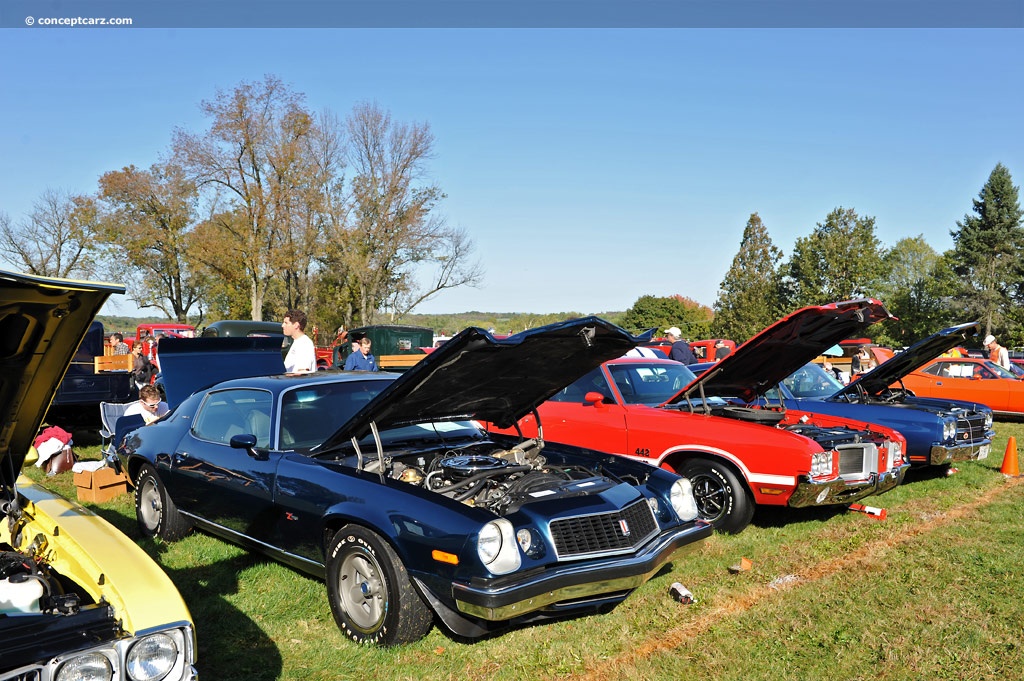
LT Hardtop Coupe
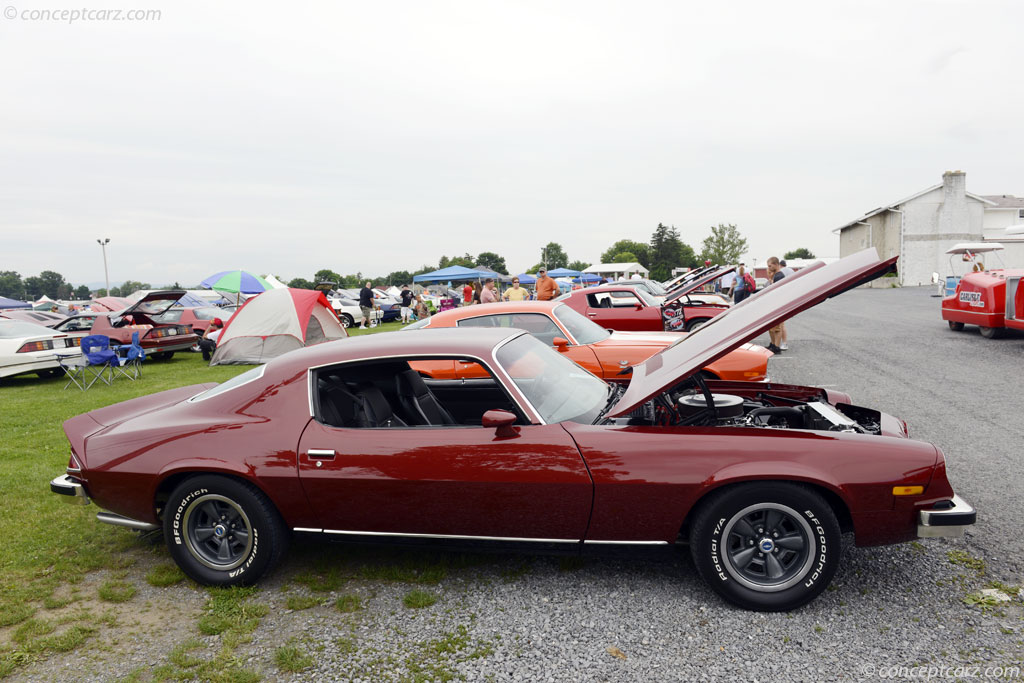
LT Hardtop Coupe
View info and history
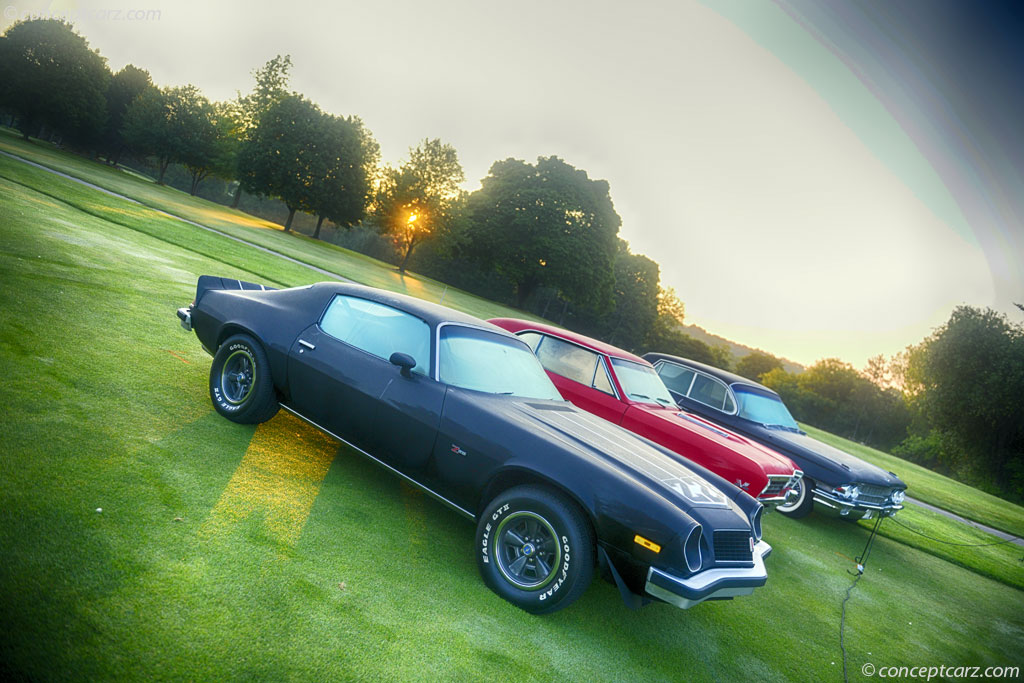
Hardtop Coupe
For 1974, the Camaro was given a major restyling, and the LT package (first appearing in 1973) continued to be part of the options list. The LT package was a 'luxury' package while the Z/28 option was a 'performance' and 'appearance' package. The Z28 option added bolder graphics and decals, stripes that ran the length of the hood and deck lid, and a 350 cubic-inch V8 rated at 245 horsepower. This was the final year for the RPO Z28 before it briefly entered retirement, only to be revived in 1977 as its own model instead of an RPO. The overall length of the 1974 Camaro grew by seven inches due to the new aluminum bumpers and a forward-sloping grille. In the back, the previous round taillights were replaced with a rectangular wraparound design. It had an egg-crate-type grille, and this was the final year for the flat rear window, with thick roof pillars. Later years wore slimmer roof pillars and a wraparound rear window.For 1974, the Camaro was given a forward-angled grille, wider front bumpers, and an egg-crate-type grill. The four-round taillamps were replaced with large lenses that wrapped around the body corners. Pricing for the base coupe began at $3,160 while the LT option sold for $3,715. For 1974, Chevrolet produced 146,595 Camaro's for the domestic market, with 4,142 being built for export. 13,803 examples were fitted with the Z28 package, the highest figure for the 2nd-generation Z28 Camaro. The dramatic increase in sales is partly attributed to Ford downsizing its Mustang to the all-new Mustang II subcompact based on the Pinto. While this may have helped Camaro sales, the Mustang II sales were also positive with 385,993 units produced for the model year, spurred on the energy crises, high gas prices, fuel shortages, and the Arab Oil Embargo. Additionally, Mercury moved its Cougar to a larger, intermediate-sized platform where it could better compete in the personal luxury segment with the Chevy Monte Carlo and the Pontiac Grand Prix. Chrysler discontinued its Plymouth Barracuda and Dodge Challenger, and the final year of the AMC Javelin.
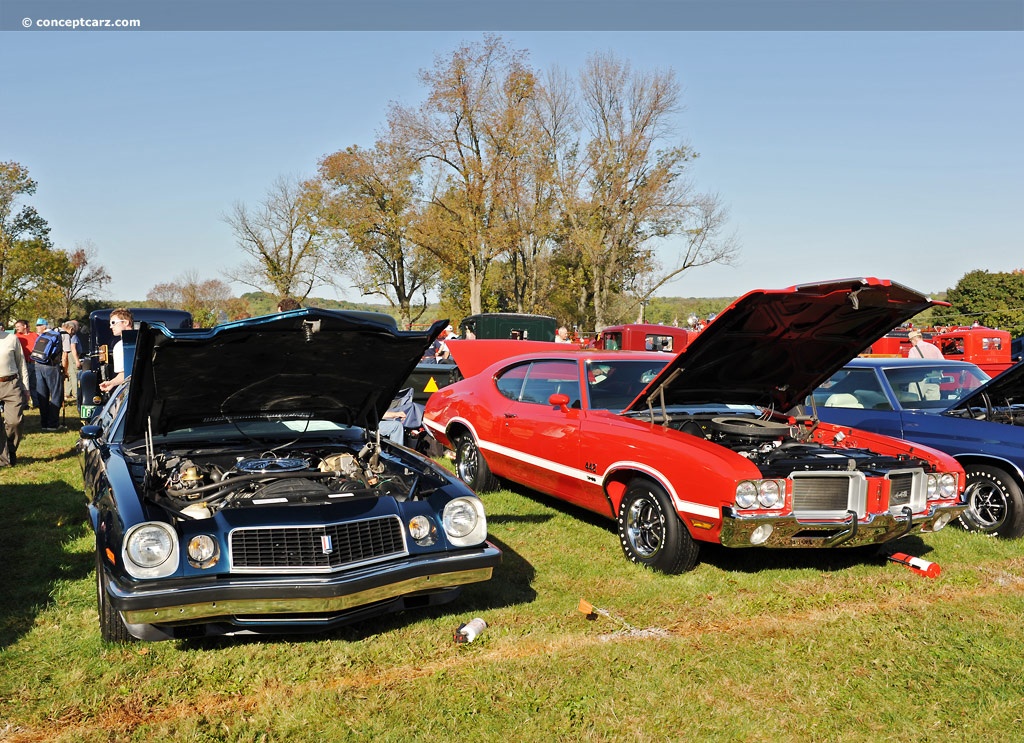
LT Hardtop Coupe
by Daniel Vaughan | Jun 2014
Related Reading : Chevrolet Camaro History
The Chevrolet Camaro was introduced in 1967 as a compact car specifically built to provide competition for the highly popular Ford Mustang. This pony car was built atop of the same F-Body platform as the Pontiac Firebird, which had a similar production lifespan of 1967 through 2002. During the preproduction stages of the Chevrolet Camaro, General Motors codenamed the vehicle Panther. The name....
Continue Reading >>
Continue Reading >>
- 1974 Chevrolet Camaro Menu
- Article
- Image gallery
- Valuation
- Specifications
- Profiles
- Recalls
Chevrolet
Similar Vehicles
Similar Automakers
Similarly Sized Vehicles
from 1974
- AMC Javelin
Chevrolet Camaro IROC Race Car
Chevrolet Nova
Lamborghini Bravo
Mercedes-Benz 240D
Mercedes-Benz 280C
Mercedes-Benz 450 Series
Mercury Comet
Plymouth Barracuda
Similarly Priced Vehicles
- Triumph TR6 ($3,300-$3,300)
- AMC Javelin ($3,000-$3,300)
- Volkswagen Beetle ($2,624-$3,500)
- Chevrolet Chevelle ($3,049-$4,500)
- Pontiac Firebird ($3,335-$4,446)
- Ford Torino ($3,175-$4,375)
- Volkswagen Karmann-Ghia ($3,474-$3,900)
- Fiat 124 ($2,799-$4,400)
- Ford Mustang ($3,080-$3,620)
Average Auction Sale: $17,830
1974 Chevrolet Camaro Vehicle Profiles
Recent Vehicle Additions
Performance and Specification Comparison
Price Comparison
$2,085 - $2,400
$2,810 - $3,105
$3,049 - $4,500
$3,720 - $4,500
$3,885 - $4,127
$4,460 - $4,915
$6,155 - $6,375
Camaro Generation 2 Specification Comparison by Year
Year
Production
Wheelbase
Engine
Prices
108.00 in.
6 cyl., 250.00 CID., 155.00hp
8 cyl., 307.00 CID., 200.00hp
8 cyl., 350.00 CID., 300.00hp
8 cyl., 454.00 CID., 360.00hp
8 cyl., 402.00 CID., 375.00hp
8 cyl., 307.00 CID., 200.00hp
8 cyl., 350.00 CID., 300.00hp
8 cyl., 454.00 CID., 360.00hp
8 cyl., 402.00 CID., 375.00hp
$2,725 - $3,888
114,630
108.00 in.
6 cyl., 250.00 CID., 145.00hp
8 cyl., 307.00 CID., 200.00hp
8 cyl., 350.00 CID., 270.00hp
8 cyl., 402.00 CID., 300.00hp
8 cyl., 350.00 CID., 330.00hp
8 cyl., 307.00 CID., 200.00hp
8 cyl., 350.00 CID., 270.00hp
8 cyl., 402.00 CID., 300.00hp
8 cyl., 350.00 CID., 330.00hp
$2,760 - $3,940
68,656
108.00 in.
6 cyl., 250.00 CID., 110.00hp
8 cyl., 307.00 CID., 130.00hp
8 cyl., 350.00 CID., 200.00hp
8 cyl., 402.00 CID., 240.00hp
8 cyl., 454.00 CID., 270.00hp
8 cyl., 327.00 CID., 350.00hp
8 cyl., 307.00 CID., 130.00hp
8 cyl., 350.00 CID., 200.00hp
8 cyl., 402.00 CID., 240.00hp
8 cyl., 454.00 CID., 270.00hp
8 cyl., 327.00 CID., 350.00hp
$2,730 - $2,730
89,988
108.00 in.
6 cyl., 250.00 CID., 100.00hp
8 cyl., 307.00 CID., 115.00hp
8 cyl., 350.00 CID., 145.00hp
8 cyl., 350.00 CID., 175.00hp
8 cyl., 350.00 CID., 245.00hp
8 cyl., 307.00 CID., 115.00hp
8 cyl., 350.00 CID., 145.00hp
8 cyl., 350.00 CID., 175.00hp
8 cyl., 350.00 CID., 245.00hp
$2,780 - $3,270
146,595
106.00 in.
6 cyl., 250.01 CID., 110.00hp
8 cyl., 350.00 CID., 145.00hp
8 cyl., 400.00 CID., 150.00hp
8 cyl., 350.00 CID., 160.00hp
8 cyl., 350.00 CID., 185.00hp
8 cyl., 454.00 CID., 235.00hp
8 cyl., 350.00 CID., 250.00hp
8 cyl., 350.00 CID., 145.00hp
8 cyl., 400.00 CID., 150.00hp
8 cyl., 350.00 CID., 160.00hp
8 cyl., 350.00 CID., 185.00hp
8 cyl., 454.00 CID., 235.00hp
8 cyl., 350.00 CID., 250.00hp
$3,160 - $3,700
141,629
106.00 in.
6 cyl., 250.00 CID., 105.00hp
8 cyl., 350.00 CID., 145.00hp
8 cyl., 350.00 CID., 155.00hp
8 cyl., 350.00 CID., 145.00hp
8 cyl., 350.00 CID., 155.00hp
$3,540 - $4,050
182,959
108.00 in.
6 cyl., 250.00 CID., 105.00hp
8 cyl., 305.00 CID., 140.00hp
8 cyl., 350.00 CID., 145.00hp
8 cyl., 350.00 CID., 165.00hp
8 cyl., 400.00 CID., 175.00hp
8 cyl., 454.00 CID., 235.00hp
8 cyl., 305.00 CID., 140.00hp
8 cyl., 350.00 CID., 145.00hp
8 cyl., 350.00 CID., 165.00hp
8 cyl., 400.00 CID., 175.00hp
8 cyl., 454.00 CID., 235.00hp
$3,760 - $4,320
218,853
108.00 in.
6 cyl., 250.00 CID., 110.00hp
8 cyl., 305.00 CID., 145.00hp
8 cyl., 350.00 CID., 170.00hp
8 cyl., 305.00 CID., 145.00hp
8 cyl., 350.00 CID., 170.00hp
$4,115 - $5,170
272,631
108.00 in.
6 cyl., 250.00 CID., 110.00hp
8 cyl., 305.00 CID., 145.00hp
8 cyl., 350.00 CID., 170.00hp
8 cyl., 350.00 CID., 185.00hp
8 cyl., 305.00 CID., 145.00hp
8 cyl., 350.00 CID., 170.00hp
8 cyl., 350.00 CID., 185.00hp
$4,420 - $5,600
282,571
108.00 in.
6 cyl., 250.00 CID., 115.00hp
8 cyl., 305.00 CID., 130.00hp
8 cyl., 350.00 CID., 175.00hp
8 cyl., 305.00 CID., 130.00hp
8 cyl., 350.00 CID., 175.00hp
$4,670 - $6,120
152,005
108.00 in.
6 cyl., 231.00 CID., 110.00hp
6 cyl., 229.00 CID., 115.00hp
8 cyl., 267.00 CID., 120.00hp
8 cyl., 305.00 CID., 155.00hp
8 cyl., 350.00 CID., 190.00hp
6 cyl., 229.00 CID., 115.00hp
8 cyl., 267.00 CID., 120.00hp
8 cyl., 305.00 CID., 155.00hp
8 cyl., 350.00 CID., 190.00hp
$5,500 - $7,120
126,138
108.00 in.
6 cyl., 229.00 CID., 110.00hp
6 cyl., 229.00 CID., 110.00hp
8 cyl., 267.00 CID., 115.00hp
8 cyl., 305.00 CID., 150.00hp
8 cyl., 305.00 CID., 165.00hp
8 cyl., 350.00 CID., 175.00hp
6 cyl., 229.00 CID., 110.00hp
8 cyl., 267.00 CID., 115.00hp
8 cyl., 305.00 CID., 150.00hp
8 cyl., 305.00 CID., 165.00hp
8 cyl., 350.00 CID., 175.00hp
$6,800 - $8,300
